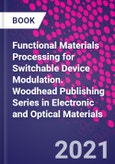Functional Materials Processing for Switchable Device Modulation focuses on the advances of nanofabrication that underpin emerging technologies, including electronic devices. The book provides readers with a broad view of the materials' perspectives, including historical context and background, along with future opportunities for smart electronic and switchable devices. A major focus in the book is on the research and development of synthetic materials for spectroscopic analysis which broadly deals with science and technology of materials on the atomic and molecular scale. The book reviews the materials and advances in research for switchable electronics for bioelectronic, sensing and optoelectronic applications.
In addition, key challenges and emerging opportunities in innovations in surface modification and novel functional materials device implementation for industrial scale reproducibility are discussed. The book covers the applications and market potential for a variety of media, including mirrors, glazing/coatings, and display products. The physics, electrochemistry, device design and materials are detailed, with performance compared between the most relevant and emerging switchable technologies.
Please Note: This is an On Demand product, delivery may take up to 11 working days after payment has been received.
Table of Contents
1. State and art for the fabrication of novel functional materials: Switchable device modulation techniques2. Ultra-thin graphene synthesis: Fundamental applications in transparent electrodes and supercapacitor
3. Recent progress on 'Graphene' as photo-sensitive switchable device
4. Superior fast switching on Graphene self-assembly with liquid crystalline optical materials
5. Textural phase transition of liquid crystalline hybrid composite bi-stable electro-optic switching
6. Controllable photo-induced switching-organic electronic devices
7. Intrinsic photovoltaic effect- organometallic perovskite switchable devices
8. Emergence of organic-inorganic solar cell for architecture: Switchable glazing
9. Challenges and opportunities of materials commercialization: Photonic, electronic, switchable sensor analysis
10. Resistive switching on bio-inspired natural solid polymer electrolytes
11. A new frontier in switchable bio-electronics and bio-nanotechnology interfaces
12. Optically tunable switching of DNA based biopolymer
13. Conclusion, outlook, future aspects and utilization of functional materials novel switching
Authors
Kaushik Pal Department of Nanotechnology, Bharath University, India. Kaushik Pal is Research Professor in the Department of Nanotechnology, Bharath University, India. His research focuses on nanofabrication, functional materials, carbon nanotubes, and nanoscale sensing technologies. Sabu Thomas Professor and Director, International and Interuniversity Centre for Nanoscience and Nanotechnology, Mahatma Gandhi University, India.Prof. Sabu Thomas is a Professor of Polymer Science and Engineering and the Director of the School of Energy Materials at Mahatma Gandhi University, India. Additionally, he is the Chairman of the Trivandrum Engineering Science & Technology Research Park (TrEST Research Park) in Thiruvananthapuram, India. He is the founder director of the International and Inter-university Centre for Nanoscience and Nanotechnology at Mahatma Gandhi University and the former Vice-Chancellor of the same institution.
Prof. Thomas is internationally recognized for his contributions to polymer science and engineering, with his research interests encompassing polymer nanocomposites, elastomers, polymer blends, interpenetrating polymer networks, polymer membranes, green composites, nanocomposites, nanomedicine, and green nanotechnology. His groundbreaking inventions in polymer nanocomposites, polymer blends, green bionanotechnology, and nano-biomedical sciences have significantly advanced the development of new materials for the automotive, space, housing, and biomedical fields. Dr. Thomas has been conferred with Honoris Causa (DSc) by the University of South Brittany, France.








